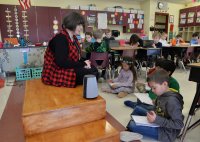‘Alexa, Do You Belong in the Classroom?’
Educators balance privacy concerns with learning possibilities when considering the use of voice devices in the classroom.
Your content has been saved!
Go to My Saved Content.Voice technology like that used by Amazon’s Alexa, Google Assistant, and Apple’s Siri allows users to access information on the internet through voice commands. Integrating voice technology in the classroom can enhance learning and engagement.
Smart speakers in the classroom can be beneficial for instruction because they are more communal in nature than a laptop or tablet. It’s easier to limit off-task behavior on a voice device than other personal devices like phones and laptops because there’s no need for students to look away from the class discussion. With other devices, students may begin looking up an answer, but then look at material not related to the original task. With voice, answers can be given without distraction.
While there are many useful applications of voice technology in the classroom, student privacy remains a top concern for educators and parents. Melissa Campbell, communications manager for the Campaign for a Commercial-Free Childhood, warns that adults should be wary of how much time children spend with these devices and how they are being influenced. She says voice devices can normalize surveillance and influence biases about certain products or companies. There are also concerns about data collection by the companies that create the devices.
Considering Voice Device Use
Whether to use voice technology in the classroom is a complex decision—here are some helpful guidelines when considering using these devices.
Know the limitations: No technology can take the place of a relationship. Teachers should use voice technology to enhance the learning experience they direct. As with any educational technology tool, teachers should set rules about voice device use in the classroom. Make it clear to students when they are allowed to access the device and the expectations for use. The technology should not be an earned reward but rather a tool for learning.
Set boundaries on the device itself: In our school, we use the Echo Dot Kids Edition because of a feature called FreeTime. If a student asks for an inappropriate or untimely search in the classroom, FreeTime prevents it and responds, “I am not able to answer that.” FreeTime also allows adults to filter explicit music, manage content, and set time limits for usage of the Alexa device, based on the user.
Turn off voice purchasing and location services: You don’t want your students placing unauthorized orders. When the microphone is not in use, mute it so that the device cannot be accessed intentionally or unintentionally when not teacher directed.
Don’t share personal information: Make sure that students are not sharing specific personal information with the device. Their name, address, and age should not be part of any response to questions. Our students use numbers instead of their names. Anytime the device asks for a student’s name, they share their number or occasionally make up a nickname. Do not associate a device to a person, but instead create a new account with no associated browsing history.
Opportunities for Use
Voice technology can be used in explicit or subtle ways in the classroom to enhance learning and increase engagement.
Music and white noise: The use of sound to set the tone of the classroom is not new, but the ability to access sound quickly with a voice command is. Teachers don’t have to stop what they’re doing to add sound or white noise to the room. With one sentence, they can stay fully involved in their work while making an adjustment to the classroom environment.
Timers, routines, and schedules: Create efficiencies for yourself and your students by setting up reminders throughout the day. One teacher at my school created a routine for her class so that when a substitute teacher fills in, the class is reminded when it is time to transition to the next lesson or event of the day. Increase face time with students by creating efficiencies in your own schedule using voice commands. Add meetings to Google Calendar directly through a voice user interface. Some educational platforms, such as the learning management system Canvas, allow voice technology for tools like hearing a to-do list inside the platform.
Stories and books: One of the most obvious ways to use voice devices is to ask them to read to students. The Echo Dot will access materials directly from Audible. But beyond typical reading, devices have the capability to make stories interactive. Capstone Publishing created a series called “You Choose,” which provides readers with choices along the way that allow them to determine how the book will progress.
Drills and memorization: Devices can be used to help students memorize information such as their multiplication facts, spelling words, or foreign language vocabulary. The quiz format is engaging and fun.
Personalization: Using the Amazon Skill Blueprints tool, educators without coding ability can create interactions for specific content in their classroom. For example, using the quiz template, teachers can quiz students on a book they’re reading in class. Once created, these quizzes can be shared if students have a voice device at home.
Every educator has to weigh the pros and cons of using voice technology in the classroom. Used appropriately, it has enhanced the educational experiences of our students and has provided opportunities for engagement and exploration beyond the classroom.
